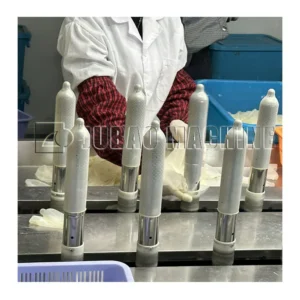Are All Condoms Electronically Tested?
Table of Contents
Introduction
When it comes to sexual health and contraception, condom reliability is paramount. One of the most frequently asked questions by consumers is whether all condoms undergo electronic testing to ensure their integrity. The short answer is more nuanced than a simple yes or no, as testing methods vary significantly across manufacturers and regulatory requirements.
Understanding condom testing procedures is crucial for consumer confidence and public health. While electronic testing represents one of the most advanced methods for detecting defects, the reality is that not all condoms receive this level of scrutiny. This comprehensive guide explores the various testing methods used in the condom industry, with particular focus on electronic detection systems.
Electronic Testing Overview
Electronic testing of condoms represents a significant advancement in quality control technology. Unlike traditional testing methods that rely on sampling, electronic testing can potentially examine every single condom produced. However, the implementation of such systems varies considerably across different manufacturers and regions.
The primary advantage of electronic testing lies in its ability to detect microscopic defects that might otherwise go unnoticed. These systems can identify pinholes, thin spots, and other structural weaknesses that could compromise the condom’s effectiveness.
The Condom Pinhole Tester Technology
The condom pinhole tester represents one of the most sophisticated electronic testing methods available in the industry. This technology uses electrical conductivity principles to detect even the smallest holes or defects in latex and non-latex condoms.

How Condom Pinhole Testers Work
A condom pinhole tester operates by creating an electrical field around the condom. When the condom is filled with a conductive solution (usually salt water), any hole or defect allows the electrical current to pass through, triggering an alarm or rejection mechanism. This method can detect holes as small as 10 micrometers in diameter.
Advantages of Pinhole Testing Technology
The condom pinhole tester offers several significant advantages over traditional testing methods:
Comprehensive Coverage: Unlike sampling methods that test only a fraction of production, pinhole testers can examine every single condom manufactured. This ensures that defective products are identified and removed before reaching consumers.
Sensitivity: These systems can detect defects far smaller than what human inspection or basic air testing might miss. The sensitivity of modern pinhole testers exceeds what is typically required by international standards.
Speed: Electronic testing is significantly faster than manual testing methods, allowing for high-volume production without compromising quality control.
Different Testing Methods
The condom industry employs various testing methods, each with distinct advantages and limitations. Understanding these different approaches helps explain why not all condoms receive electronic testing.
Air Burst Testing
Air burst testing involves inflating condoms with air until they burst, measuring the volume and pressure at failure. This method tests the overall strength and elasticity of the material but is typically performed on samples rather than every condom produced.
Water Leak Testing
Water leak testing fills condoms with water to check for leaks. While effective for detecting larger holes, this method may miss microscopic defects that could still compromise effectiveness. Additionally, water testing is time-consuming and not practical for testing every condom in large-scale production.
Electronic Pinhole Detection
As discussed earlier, electronic pinhole detection using specialized condom pinhole tester equipment represents the most advanced testing method. However, the high cost of implementation means that not all manufacturers have adopted this technology.
Industry Standards and Regulations
International standards for condom testing vary significantly between different regulatory bodies and regions. The World Health Organization (WHO), International Organization for Standardization (ISO), and various national health authorities have established different requirements for condom testing.
Most international standards require sampling-based testing rather than 100% electronic testing. For example, ISO 4074 standards typically require testing of samples from each production batch rather than individual testing of every condom. This approach balances quality assurance with economic feasibility.
Regional Variations in Testing Requirements
Different countries and regions have varying requirements for condom testing. Some developed countries have stricter standards that may encourage or require more comprehensive testing methods, while others rely primarily on sampling-based approaches.
Manufacturing Process and Quality Control
The integration of electronic testing into the manufacturing process requires significant investment in equipment and training. Manufacturers must weigh the costs of implementing comprehensive electronic testing against the benefits of improved quality control.
Large-scale manufacturers serving premium markets are more likely to invest in advanced electronic testing systems, including condom pinhole tester technology. Smaller manufacturers or those serving price-sensitive markets may rely more heavily on sampling-based testing methods.
Cost-Benefit Analysis
The decision to implement electronic testing involves complex cost-benefit calculations. While the technology significantly improves quality control, the initial investment and ongoing operational costs can be substantial. Manufacturers must consider factors such as market positioning, regulatory requirements, and consumer expectations.
Limitations and Challenges
Despite the advantages of electronic testing, several challenges prevent universal adoption across the industry.
Economic Constraints
The high cost of condom pinhole tester equipment and other electronic testing systems creates barriers for smaller manufacturers. This economic reality means that not all condoms on the market receive the same level of testing.
Technical Limitations
While electronic testing is highly effective, it is not infallible. Some types of defects may not be detected by electronic methods, and the technology requires careful calibration and maintenance to function properly.
Production Speed Considerations
Although electronic testing is faster than manual methods, integrating comprehensive testing into high-speed production lines can still present logistical challenges. Manufacturers must balance testing thoroughness with production efficiency.
Consumer Confidence and Safety
Understanding the testing methods used by different manufacturers can help consumers make informed choices about condom selection. While not all condoms receive electronic testing, products from reputable manufacturers that meet international standards generally provide reliable protection.
Consumers should look for condoms that meet recognized international standards such as ISO 4074 or equivalent national standards. These standards ensure that adequate testing has been performed, even if it may not involve comprehensive electronic testing of every unit.
What Consumers Can Do
Consumers can research manufacturers’ testing procedures and quality control measures. Some companies publicly disclose their use of advanced testing methods, including condom pinhole tester technology, as a marketing differentiator.

Conclusion
The question “Are all condoms electronically tested?” reveals the complexity of quality control in the condom industry. While electronic testing methods, including sophisticated condom pinhole tester systems, represent the gold standard for defect detection, they are not universally implemented across all manufacturing facilities.
The reality is that testing methods vary significantly based on manufacturer capabilities, regulatory requirements, and market positioning. While comprehensive electronic testing would be ideal from a quality control perspective, economic and practical considerations mean that many manufacturers rely on sampling-based testing methods that still provide adequate safety assurance when properly implemented.
For consumers, the key is to choose condoms from reputable manufacturers that adhere to recognized international standards. While not every condom may undergo individual electronic testing, products that meet established quality standards provide reliable protection when used correctly.
As technology continues to advance and costs decrease, it is likely that electronic testing methods will become more widespread throughout the industry. Until then, understanding the current landscape of condom testing helps consumers make informed decisions about their sexual health and safety.
